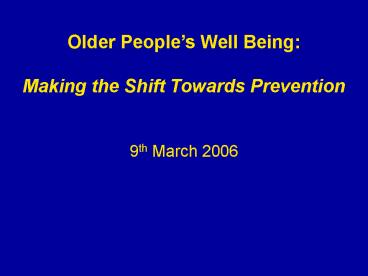Older Peoples Well Being: - PowerPoint PPT Presentation
1 / 13
Title:
Older Peoples Well Being:
Description:
Public Health and the Preventative Agenda. Carl Petrokofsky - Snr PH Mgr ... Build strength, stamina, flexibility, balance. Secondary. Reduce social isolation ... – PowerPoint PPT presentation
Number of Views:24
Avg rating:3.0/5.0
Title: Older Peoples Well Being:
1
Older Peoples Well Being Making the Shift
Towards Prevention 9th March 2006
2
Public Health and the Preventative Agenda Carl
Petrokofsky - Snr PH Mgr South East Public Health
Group Older People Opportunities for Public
Health Action Dr Mike Gill - Regional Director of
Public Health- South East South East Public
Health Group Health Promotion in Extra Care
Settings Michael Bridges - Principal Health
Promotion Adviser Eastern Cheshire PCT
3
- Policy Context
- Social Exclusion Unit Reports March 2005/Jan
2006 - House of Lords committee report July 2005
- Rowntree Report on long term care August 2005
- NAO report on stroke services - Autumn 2005
- Opportunity Age DWP - Spring 2005
- NICE Improving Health in Mid Life 2005
- Everybodys Business MH Services for Older
Adults -2005 - Elder Abuse - Sept 2004
- Choosing Health Nov 2005
4
- Choosing Health aims to
- Increase quality of life and life expectancy
- Reduce inequalities in health
- Improve the chances people have, to engage in
healthy choices - Encourage healthy lifestyles
5
- A Sure Start to Later Life Ending Inequalities
for Older People - Key themes
- Independence, Dignity, Choice
- Use the approach of Sure Start for Older People
- Achieve Basic Stds of Health and Wealth and
Housing - Quality of Life participation continue having
meaningful relationships and roles - Building Inclusive Communities contribution plus
safety, access to services, transport - Strong leadership/citizenship equality and
discrimination
6
1 - Early intervention and low-level services
Early intervention and low level services
- The current provision of services for excluded
older people is focused on providing intensive,
costly services once problems arise. - Shifting the emphasis to providing lower level
services, earlier - before people develop
intensive needs - means there will be less need
for intensive services in the future. This is
better for individuals and less costly.
Relatively small numbers of people with high
levels of need receiving care. Larger numbers
of people who fall outside eligibility criteria
for services but may benefit from lower level
services.
Improved access to universal
services. Better joined up rehabilitation servi
ces. Lower levels of high cost intensive care
services.
Adapted from ADSS/LGA All our tomorrows
7
Big Wins from Choosing Health
8
Early intervention and low level services
The right bit of help, for the right person
...the same services will affect people
differently...
Physical and Practical
Personal and Social
9
What future services might look like for an
excluded older person?
Joined up and co-ordinated services
- A SURE START model would enable a person
entering at any place in the system to receive a
seamless service. - Key features
- As access to services is critical for excluded
older people - this could be via an outreach
service, or via the voluntary sector. - The services available would not be limited to
core statutory services. The voluntary and
community sector would be fully involved and low
level would be part of the provision. - There would be local involvement in the
direction of the service.
Finance benefits
Advocacy specialist advice
Safety environment
Housing
Transport
Excluded older person
Social care
Social activities
Health
10
(No Transcript)
11
- LOCAL AREA AGREEMENT
- 3 year agreement that sets out the priorities
for a local area agreed between central
government and a local area (represented by the
LA, LSP, and other key partners) - It will be refreshed annually
- LAAs are outcome based and enable LAs and their
partners to deliver national outcomes in a way
that reflects local priorities, particularly
those in Community Strategies, - A new way of managing relations between LAs and
Govt - Brings together many different funding streams
and priorities - Set out in 4 Blocks Healthy Communities OP
Block
12
Social Exclusion it isnt just a black and
white issue
13
- Key Questions for the Workshop
- Your team has 50k over 3 years to spend as a LAA
Pump Priming Grant - What are the public health big wins?
- What are the key obstacles to developing the
Single Accessible Gateway to services? - Is the Single Assessment Framework the route to
achieve this? - Whats stopping this?
- How can we use the LAA process to support this?
- How can we provide both the high intensive levels
of support required awa the low level preventive
services which reduce the demand in the high
intensive end. (Is it possible to invert the
triangle?) - How can we rapidly spread adoption of good (world
class) practice esp. within an increasingly
pluralistic set of providers e.g. poly-pharmacy
falls practice nutrition smoking etc































